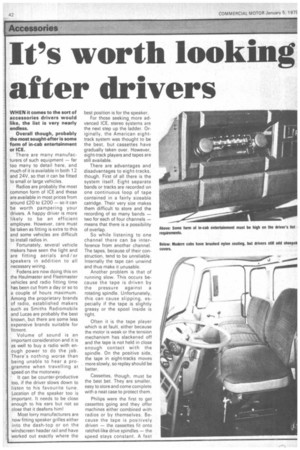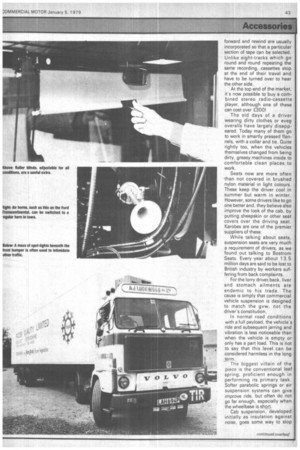Ws worth looking after drivers
Page 44

Page 45

Page 46

If you've noticed an error in this article please click here to report it so we can fix it.
WHEN it comes to the sort of accessories drivers would like, the list is very nearly endless.
Overall though, probably the most sought-after is some form of in-cab entertainment or ICE.
There are many manufacturers of such equipment — far too many to detail here, and much of it is available in both 12 and 24V, so that it can be fitted to small or large vehicles.
Radios are probably the most common form of ICE and these are available in most prices from around E.20 to E200 — so it can be worth pampering your drivers. A happy driver is more likely to be an efficient employee. However, care must be taken as fitting is extra to this and some vehicles are difficult to install radios in.
Fortunately, several vehicle makers have seen the light and are fitting aerials and /or speakers in addition to all necessary wiring.
Fodens are now doing this on the Haulmaster and Fleetmaster vehicles and radio fitting time has been cut from a day or so to a couple of hours maximum. Among the proprietary brands of radio, established makers such as Smiths Radiomobile and Lucas are probably the best known,. but there are some less expensive brands suitable for fitment.
Volume of sound is an important consideration and it is as well to buy a radio with enough power to do the job. There's nothing worse than being unable to hear a programme when travelling at speed on the motorway.
It can be counter-productive too, if the driver slows down to listen to his favourite tune. Location of the speaker too is important. It needs to be close enough to his ears but not so close that it deafens him!
Most lorry manufacturers are now fitting speaker grilles either into the dash-top or on the windscreen header rail and have '! worked out exactly where the best position is for the speaker.
For those seeking more advanced ICE, stereo systems are the next step up the ladder. Originally, the American eighttrack system was thought to be the best, but cassettes have gradually taken over. However, eight-track players and tapes are still available.
There are advantages and disadvantages to eight-tracks, though. First of all there is the system itself. Eight separate bands or tracks are recorded on one continuous loop of tape contained in a fairly sizeable catridge. Their very size makes them difficult to store and the recording of so many bands — two for eachof four channels — means that there is a possibility of overlap. So while listening to one channel there can be interference from another channel. The tapes, because of their construction, tend to be unreliable, Internally the tape can unwind and thus make it unusable.
Another problem is that of running slow. This occurs because the tape is driven by the pressure against a rotating spindle. Unfortunately, this can cause slipping, especially if the tape is slightly greasy or the spool inside is tight.
Often it is the tape player which is at fault, either because the motor is weak or the tension mechanism has slackened off and the tape is not held in close enough contact with the spindle. On the positive side, the tape in eight-tracks moves more slowly, so replay should be better_ Cassettes, though, must be the best bet. They are smaller, easy to store and come complete with a neat case to protect them.
Philips were the first to get cassettes going and they offer machines either combined with radios or by themselves. Because the tape is positively driven — the cassettes fit onto ratchet-like drive spindles — the speed stays constant. A fast forward and rewind are usually incorporated so that a particular section of tape can be selected. Unlike eight-tracks which go round and round repeating the same recording, cassettes stop at the end of their travel and have to be turned over to hear the other side.
At the top end of the market, it's now possible to buy a combined stereo radio-cassette player, although one of these can cost over £300!
The old days of a driver wearing dirty clothes or eveQ overalls have largely disappeared. Today many of them go to work in smartly pressed flannels, with a collar and tie. Quite rightly too, when the vehicles themselves changed from being dirty, greasy machines inside to comfortable clean places to work.
Seats now are more often than not covered in brushed nylon material in light colours. These keep the driver cool in summer but warm in winter. However, some drivers like to go one better and, they believe also improve the look of the cab, by putting sheepskin or other seat covers over the driving seat. Karobes are one of the premier suppliers of these.
While talking about seats, suspension seats are very much a requirement of drivers, as we found out talking to Bostrom Seats. Every year about 13.5 million days are said to be lost to British industry by workers suffering from back complaints.
For the lorry driver, back, liver and stomach ailments are endemic to his trade. The cause is simply that commercial vehicle suspension is designed to match the gvw, not the driver's constitution.
In normal road conditions with a full payload, the vehicle's ride and subsequent jarring and vibration is less noticeable than when the vehicle is empty or only has a part load. This is not to say that this level can be considered harmless in the long term. _ The biggest villain of the piece is the conventional leaf spring, proficient enough in performing its primary task. Softer parabolic springs or air suspension systems can give improve ride, but often do not go far enough, especially when the wheelbase is short.
Cab suspension, developed initially as insulation against noise, goes some way to stop shock loads being transmitted up from the road wheels, through the suspension and chassis to the driver's seat. An allowance for sufficient spring movement here though would inevitably result in excessive cab roll. It would be unreasonable to think that the thin seat squab, which is directly in contact with the driver, could have much influence.
In fact conventional seat materials, plastic and latex foams, used for their cushioning properties, can actually exaggerate the accelerations acting upon the driver.
If the problem is looked at subjectively the remedy is simple: isolate the driver from the offending vibrations. For many, these conditions can only be met by a suspension seat.
ISO recommendations on human exposure to vibration, point out that the body is least tolerant to vertical vibration in the frequency range between four to eight cycles per second. Only a suspension seat having a lower frequency than the chassis can reduce the vibration below that level. In a typical installation where vibration is at three cycles a second, a suspension seat could reduce this to about 1.8 cycles per second, whereas a static seat could actually increase vibration to as much as 7.33 cycles per second — well above the recommended level.
What must not be lost sight of here is that it is the speed and frequency that the driver is being bounced up and down that matters. In an unladen articulated vehicle a peak acceleration of 2.5 cycles per second equals an acceleration at the surface of the driver's seat of 2.5 metres/sec2 which can be reduced by over 70 per cent, by a well matched suspension seat.
Fortunately for the designer, the influencing factors tend to be similar for a given type of vehicle group so that one seat may be suitable for many different makes of commercial vehicle, but to obtain optimum performance it would need to be matched on an almost individual basis.
Just how this is done may vary from manufacturer to Manufacturer. Bostrom, a division of the American company, UOP Inc, would consider itself to be primarily a seat suspension manufacturer although it does
produce the complete package. The trick is to get the seat to remain static while the vehicle around it rides up and down.
Bostrom employs a scissor mechanism working on a torsional spring which allows up to 100mm vertical suspension stroke in conjunction with a double-acting telescopic hydraulic damper. Preloaded adjustment makes allowance for the difference in driver weight over a band from 50 to 130kg.
Unfortunately, not all of the forces act in a vertical plane and as yet have not been catered for.
Once the driver has been supplied with a stable position the location and shape of the seat assumes much greater importance. Height as well as fore and aft adjustment have to allow for many shapes and sizes of drivers to reach the controls without difficulty while the shape of the seat has to offer adequate support to the thighs and backs of those same drivers.
A choice of seat coverings too can add to the driver's efficiency. No one suffering from piles or sweat rash can be expected to have his whole heart in his job. A seat that allows the body to breathe is another must in our book.
It is not uncommon for all these features to be available as standard, in the heavier and more expensive vehicle of today. But the lighter end of the scale presents a very different picture. It is time that the drivers of these vehicles should also be able to benefit in their working environments and subsequent health from technology already available.
Other comforts apart from seats which are likely to reflect the more modern and cleaner image of drivers extend to document cases and clothes compartments to keep his bits and pieces together. The former may not sound as daft as it seems, as delivery notes and so on can easily get last in the cab. Also, it's nice for the driver.to have somewhere to keep his paper or magazine. For those on runs such as that to the Middle East, a document case could be really essential to house the multitude of permits necessary.
Roller blinds, not only on the front screen but on side windows, give the driver a degree of privacy and also perform a vital function by cutting the sun out. They are usually adjustable — that is, they can be pulled down to a required level to act as a visor.
Although mOdern vehick headlights are invariably quart; halogen or tungsten, man) drivers believe additional lights are necessary. They often have e bank of fog or spot-light: mounted below the fron bumper which look like Black pool illuminations when they'rf turned on. It's easy to believE that their true reason for fittirq them is to intimidate motorist: travelling at 50mph in the cen tre motorway lane who won' move over!
Lucas is the premier maker o' these lamps in the UK and has e wide range, suitable for vehicle! of all shapes and sizes. Foreigr makers, like Cibie and Hella alsc have models to offer. Take care though, when fitting auxiliary lamps as they have to be posi tioned correctly in relation to tht headlamps. Although the prac tice of wiring high-intensity foc rear-lamps to the stop lights is tt be outlawed people still do it It's both annoying and con fusing and detracts from thei true purpose.
Again Lucas can supply thesi lamps and they are very wortl while when used correctly in foc or poor conditions.




















































































